headlamp CADILLAC ESCALADE ESV 2008 Owner's Manual
[x] Cancel search | Manufacturer: CADILLAC, Model Year: 2008, Model line: ESCALADE ESV, Model: CADILLAC ESCALADE ESV 2008Pages: 500, PDF Size: 6.65 MB
Page 300 of 500
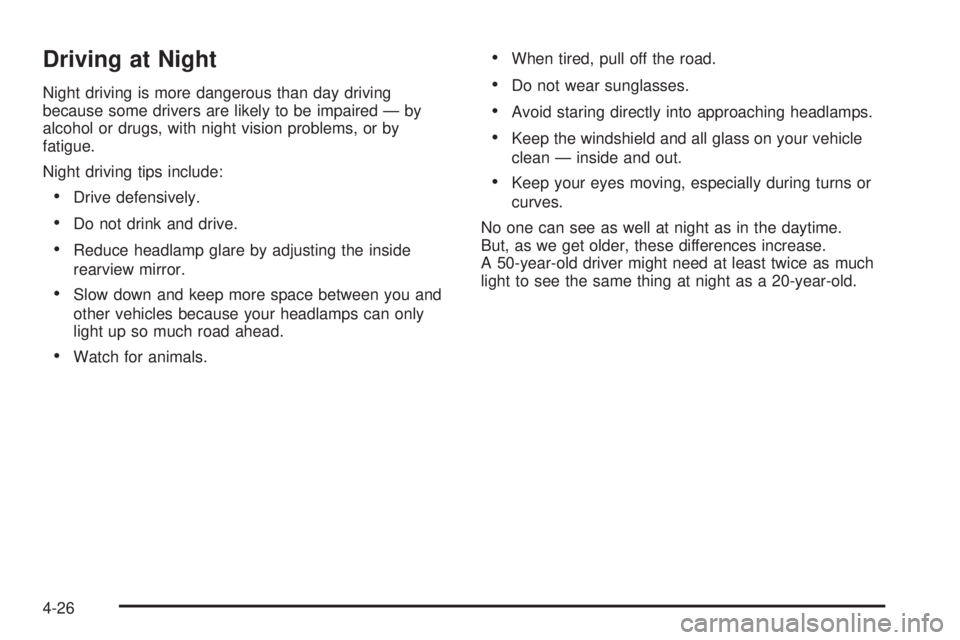
Driving at Night Night driving is more dangerous than day driving
because some drivers are likely to be impaired — by
alcohol or drugs, with night vision problems, or by
fatigue.
Night driving tips include:
Drive defensively.
Do not drink and drive.
Reduce headlamp glare by adjusting the inside
rearview mirror.
Slow down and keep more space between you and
other vehicles because your headlamps can only
light up so much road ahead.
Watch for animals. When tired, pull off the road.
Do not wear sunglasses.
Avoid staring directly into approaching headlamps.
Keep the windshield and all glass on your vehicle
clean — inside and out.
Keep your eyes moving, especially during turns or
curves.
No one can see as well at night as in the daytime.
But, as we get older, these differences increase.
A 50-year-old driver might need at least twice as much
light to see the same thing at night as a 20-year-old.
4-26
Page 306 of 500
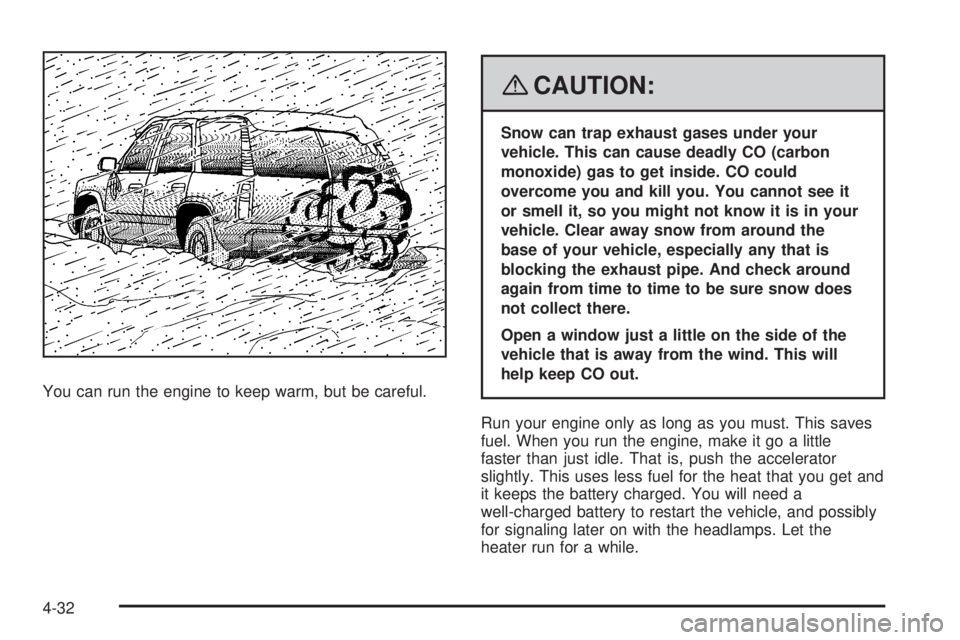
You can run the engine to keep warm, but be careful. { CAUTION: Snow can trap exhaust gases under your
vehicle. This can cause deadly CO (carbon
monoxide) gas to get inside. CO could
overcome you and kill you. You cannot see it
or smell it, so you might not know it is in your
vehicle. Clear away snow from around the
base of your vehicle, especially any that is
blocking the exhaust pipe. And check around
again from time to time to be sure snow does
not collect there.
Open a window just a little on the side of the
vehicle that is away from the wind. This will
help keep CO out.
Run your engine only as long as you must. This saves
fuel. When you run the engine, make it go a little
faster than just idle. That is, push the accelerator
slightly. This uses less fuel for the heat that you get and
it keeps the battery charged. You will need a
well-charged battery to restart the vehicle, and possibly
for signaling later on with the headlamps. Let the
heater run for a while.
4-32
Page 333 of 500
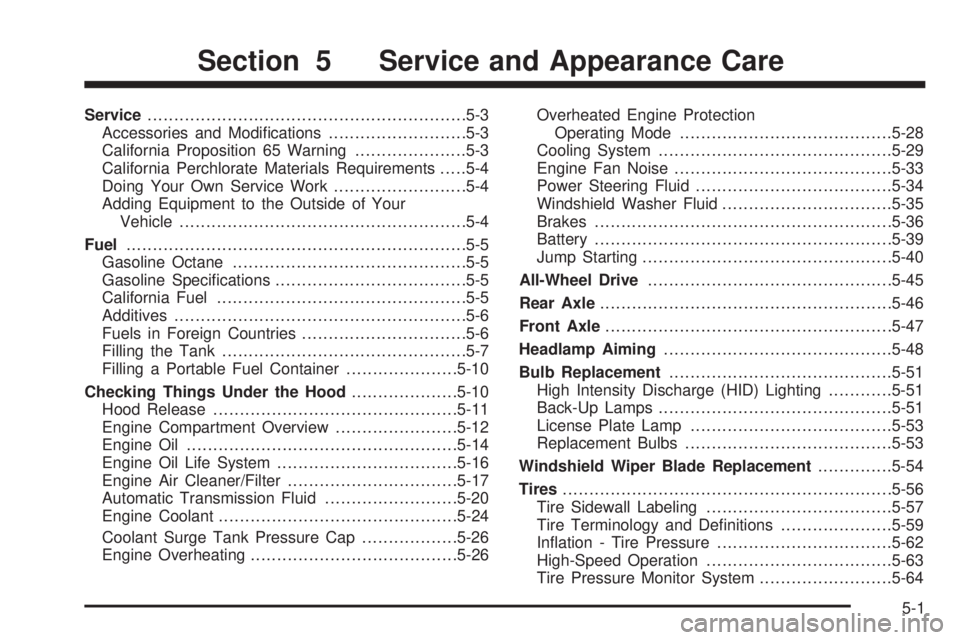
Service ........................................................... .5-3
Accessories and Modi�cations ......................... .5-3
California Proposition 65 Warning .................... .5-3
California Perchlorate Materials Requirements .... .5-4
Doing Your Own Service Work ........................ .5-4
Adding Equipment to the Outside of Your
Vehicle ..................................................... .5-4
Fuel ............................................................... .5-5
Gasoline Octane ........................................... .5-5
Gasoline Speci�cations ................................... .5-5
California Fuel .............................................. .5-5
Additives ...................................................... .5-6
Fuels in Foreign Countries .............................. .5-6
Filling the Tank ............................................. .5-7
Filling a Portable Fuel Container .................... .5-10
Checking Things Under the Hood ................... .5-10
Hood Release ............................................. .5-11
Engine Compartment Overview ...................... .5-12
Engine Oil .................................................. .5-14
Engine Oil Life System ................................. .5-16
Engine Air Cleaner/Filter ............................... .5-17
Automatic Transmission Fluid ........................ .5-20
Engine Coolant ............................................ .5-24
Coolant Surge Tank Pressure Cap ................. .5-26
Engine Overheating ...................................... .5-26 Overheated Engine Protection
Operating Mode ....................................... .5-28
Cooling System ........................................... .5-29
Engine Fan Noise ........................................ .5-33
Power Steering Fluid .................................... .5-34
Windshield Washer Fluid ............................... .5-35
Brakes ....................................................... .5-36
Battery ....................................................... .5-39
Jump Starting .............................................. .5-40
All-Wheel Drive ............................................. .5-45
Rear Axle ...................................................... .5-46
Front
Axle ..................................................... .5-47
Headlamp Aiming .......................................... .5-48
Bulb Replacement ......................................... .5-51
High Intensity Discharge (HID) Lighting ........... .5-51
Back-Up Lamps ........................................... .5-51
License Plate Lamp ..................................... .5-53
Replacement Bulbs ...................................... .5-53
Windshield Wiper Blade Replacement ............. .5-54
Tires ............................................................. .5-56
Tire Sidewall Labeling .................................. .5-57
Tire Terminology and De�nitions .................... .5-59
In�ation - Tire Pressure ................................ .5-62
High-Speed Operation .................................. .5-63
Tire Pressure Monitor System ........................ .5-64Section 5 Service and Appearance Care
5-1
Page 380 of 500
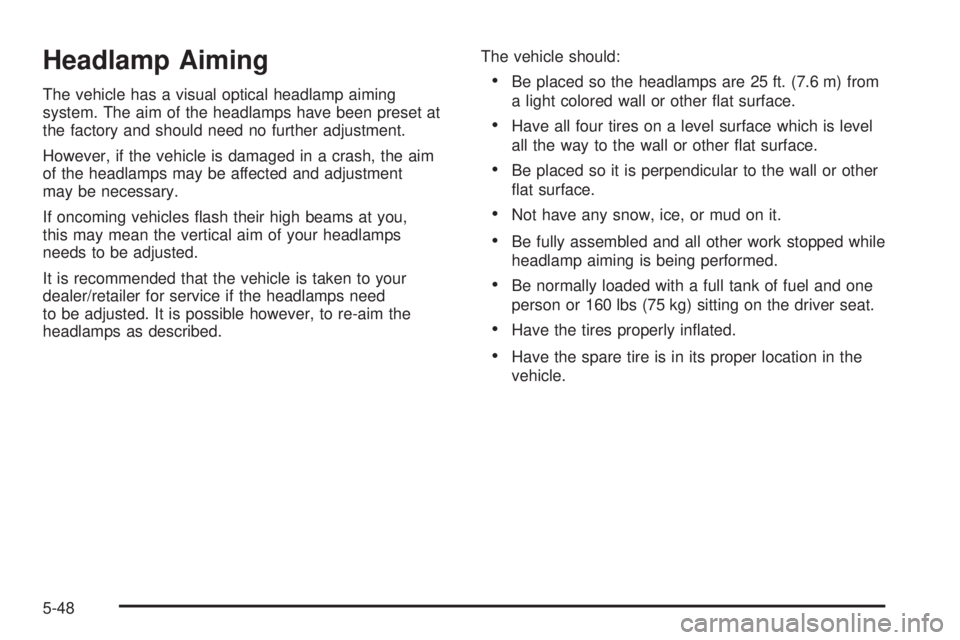
Headlamp Aiming The vehicle has a visual optical headlamp aiming
system. The aim of the headlamps have been preset at
the factory and should need no further adjustment.
However, if the vehicle is damaged in a crash, the aim
of the headlamps may be affected and adjustment
may be necessary.
If oncoming vehicles �ash their high beams at you,
this may mean the vertical aim of your headlamps
needs to be adjusted.
It is recommended that the vehicle is taken to your
dealer/retailer for service if the headlamps need
to be adjusted. It is possible however, to re-aim the
headlamps as described. The vehicle should:
Be placed so the headlamps are 25 ft. (7.6 m) from
a light colored wall or other �at surface.
Have all four tires on a level surface which is level
all the way to the wall or other �at surface.
Be placed so it is perpendicular to the wall or other
�at surface.
Not have any snow, ice, or mud on it.
Be fully assembled and all other work stopped while
headlamp aiming is being performed.
Be normally loaded with a full tank of fuel and one
person or 160 lbs (75 kg) sitting on the driver seat.
Have the tires properly in�ated.
Have the spare tire is in its proper location in the
vehicle.
5-48
Page 381 of 500
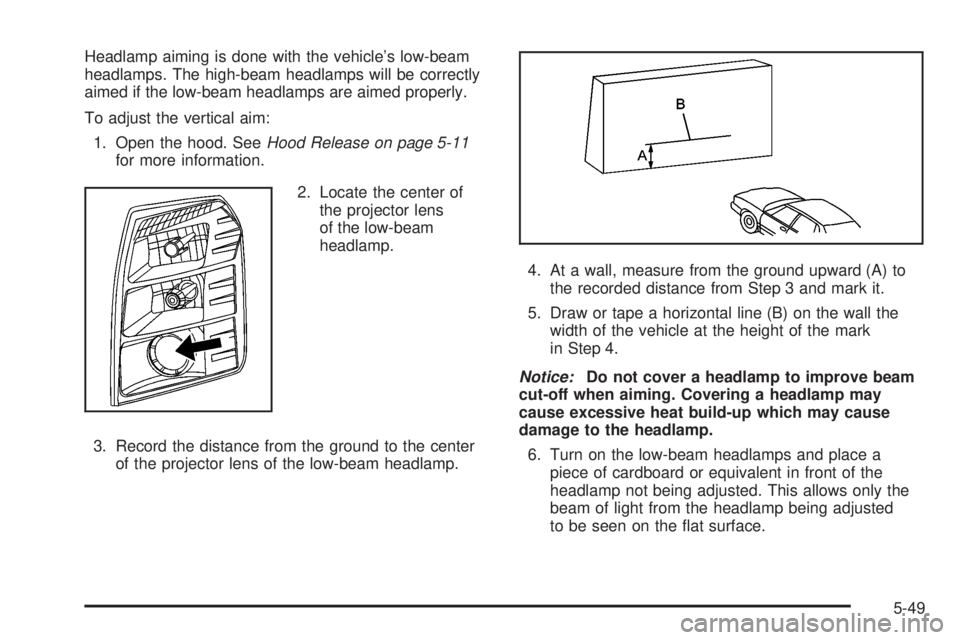
Headlamp aiming is done with the vehicle’s low-beam
headlamps. The high-beam headlamps will be correctly
aimed if the low-beam headlamps are aimed properly.
To adjust the vertical aim:
1. Open the hood. See Hood Release on page 5-11
for more information.
2. Locate the center of
the projector lens
of the low-beam
headlamp.
3. Record the distance from the ground to the center
of the projector lens of the low-beam headlamp. 4. At a wall, measure from the ground upward (A) to
the recorded distance from Step 3 and mark it.
5. Draw or tape a horizontal line (B) on the wall the
width of the vehicle at the height of the mark
in Step 4.
Notice: Do not cover a headlamp to improve beam
cut-off when aiming. Covering a headlamp may
cause excessive heat build-up which may cause
damage to the headlamp.
6. Turn on the low-beam headlamps and place a
piece of cardboard or equivalent in front of the
headlamp not being adjusted. This allows only the
beam of light from the headlamp being adjusted
to be seen on the �at surface.
5-49
Page 382 of 500
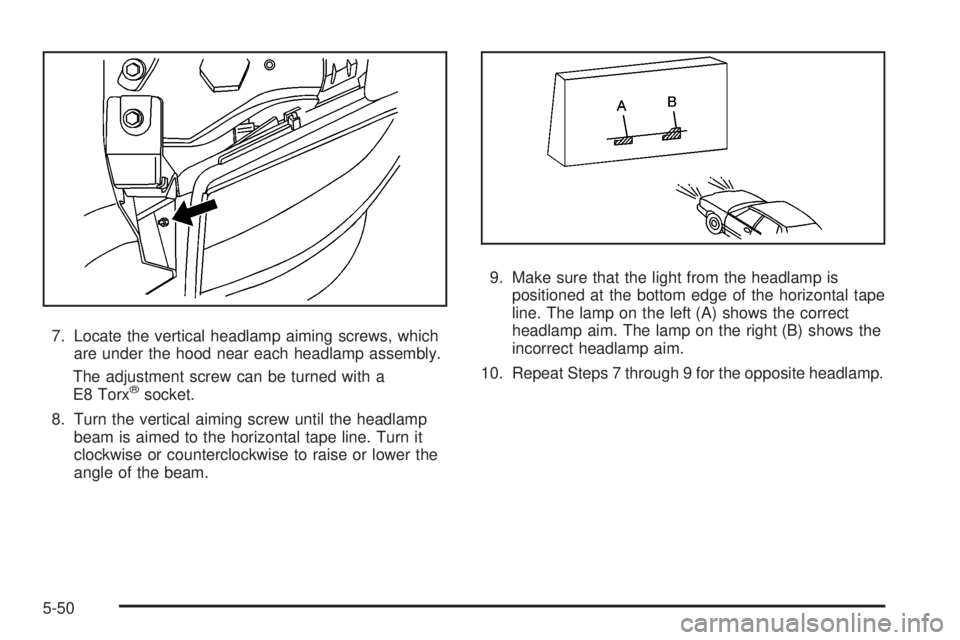
7. Locate the vertical headlamp aiming screws, which
are under the hood near each headlamp assembly.
The adjustment screw can be turned with a
E8 Torx ®
socket.
8. Turn the vertical aiming screw until the headlamp
beam is aimed to the horizontal tape line. Turn it
clockwise or counterclockwise to raise or lower the
angle of the beam. 9. Make sure that the light from the headlamp is
positioned at the bottom edge of the horizontal tape
line. The lamp on the left (A) shows the correct
headlamp aim. The lamp on the right (B) shows the
incorrect headlamp aim.
10. Repeat Steps 7 through 9 for the opposite headlamp.
5-50
Page 383 of 500
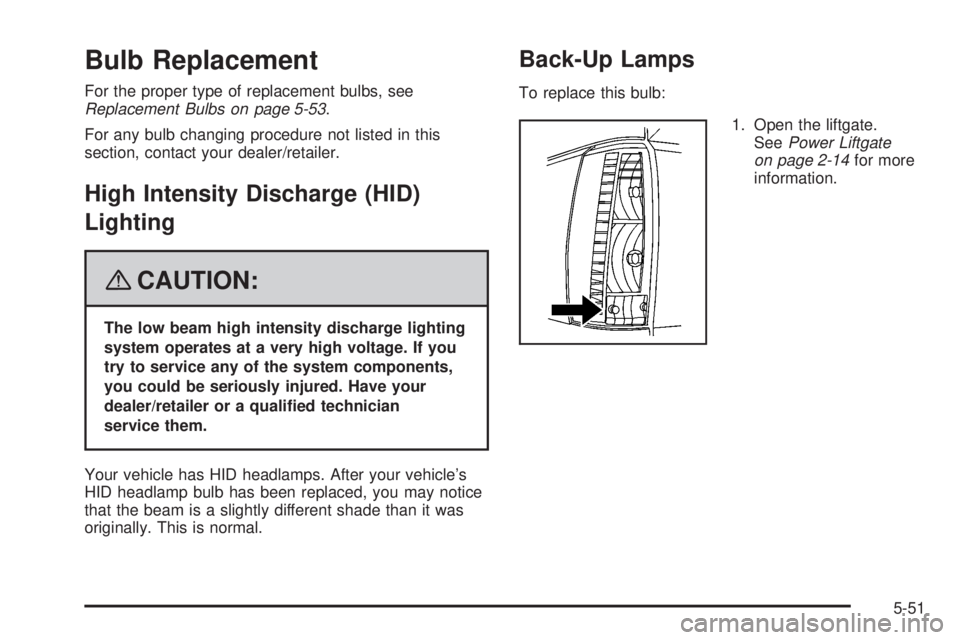
Bulb Replacement For the proper type of replacement bulbs, see
Replacement Bulbs on page 5-53 .
For any bulb changing procedure not listed in this
section, contact your dealer/retailer.
High Intensity Discharge (HID)
Lighting
{ CAUTION: The low beam high intensity discharge lighting
system operates at a very high voltage. If you
try to service any of the system components,
you could be seriously injured. Have your
dealer/retailer or a quali�ed technician
service them.
Your vehicle has HID headlamps. After your vehicle’s
HID headlamp bulb has been replaced, you may notice
that the beam is a slightly different shade than it was
originally. This is normal. Back-Up Lamps To replace this bulb:
1. Open the liftgate.
See Power Liftgate
on page 2-14 for more
information.
5-51
Page 408 of 500
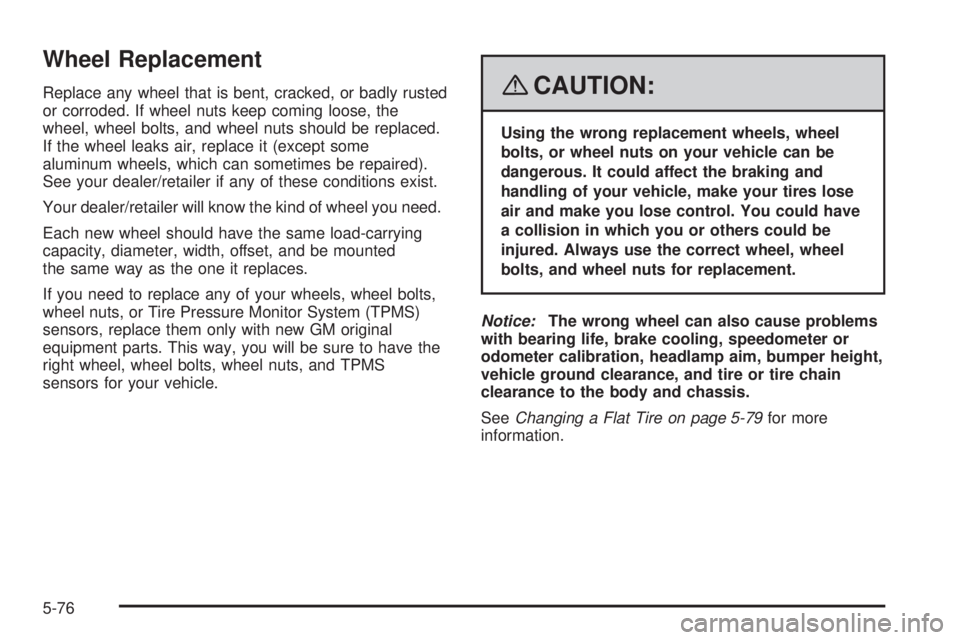
Wheel Replacement Replace any wheel that is bent, cracked, or badly rusted
or corroded. If wheel nuts keep coming loose, the
wheel, wheel bolts, and wheel nuts should be replaced.
If the wheel leaks air, replace it (except some
aluminum wheels, which can sometimes be repaired).
See your dealer/retailer if any of these conditions exist.
Your dealer/retailer will know the kind of wheel you need.
Each new wheel should have the same load-carrying
capacity, diameter, width, offset, and be mounted
the same way as the one it replaces.
If you need to replace any of your wheels, wheel bolts,
wheel nuts, or Tire Pressure Monitor System (TPMS)
sensors, replace them only with new GM original
equipment parts. This way, you will be sure to have the
right wheel, wheel bolts, wheel nuts, and TPMS
sensors for your vehicle. { CAUTION: Using the wrong replacement wheels, wheel
bolts, or wheel nuts on your vehicle can be
dangerous. It could affect the braking and
handling of your vehicle, make your tires lose
air and make you lose control. You could have
a collision in which you or others could be
injured. Always use the correct wheel, wheel
bolts, and wheel nuts for replacement.
Notice: The wrong wheel can also cause problems
with bearing life, brake cooling, speedometer or
odometer calibration, headlamp aim, bumper height,
vehicle ground clearance, and tire or tire chain
clearance to the body and chassis.
See Changing a Flat Tire on page 5-79 for more
information.
5-76
Page 444 of 500

Fuses Usage
1 Right Trailer Stop/Turn Lamp
2 Electronic Stability Suspension Control,
Automatic Level Control Exhaust
3 Left Trailer Stop/Turn Lamp
4 Engine Controls
5 Engine Control Module, Throttle Control
6 Trailer Brake Controller Fuses Usage
7 Front Washer
8 Oxygen Sensors
9 Antilock Brakes System 2
10 Trailer Back-up Lamps
11 Driver Side Low-Beam Headlamp
12 Engine Control Module (Battery)
13 Fuel Injectors, Ignition Coils
(Right Side)
14 Transmission Control Module (Battery)
15 Vehicle Back-up Lamps
16 Passenger Side Low-Beam Headlamp
17 Air Conditioning Compressor
18 Oxygen Sensors
19 Transmission Controls (Ignition)
20 Fuel Pump
21 Fuel System Control Module
22 Headlamp Washers
23 Rear Windshield Washer
24 Fuel Injectors, Ignition Coils (Left Side)
5-112
Page 445 of 500
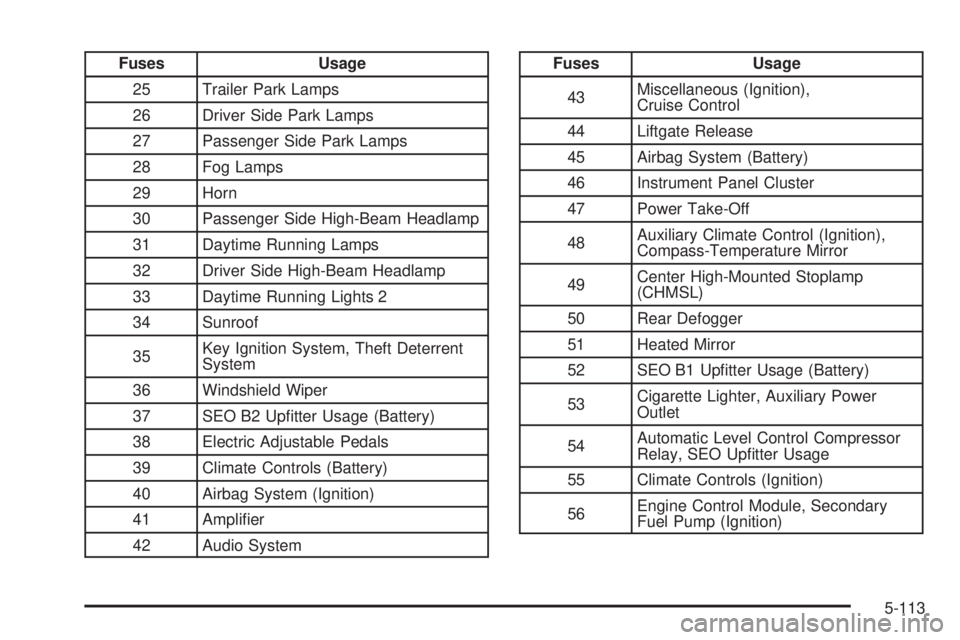
Fuses Usage
25 Trailer Park Lamps
26 Driver Side Park Lamps
27 Passenger Side Park Lamps
28 Fog Lamps
29 Horn
30 Passenger Side High-Beam Headlamp
31 Daytime Running Lamps
32 Driver Side High-Beam Headlamp
33 Daytime Running Lights 2
34 Sunroof
35 Key Ignition System, Theft Deterrent
System
36 Windshield Wiper
37 SEO B2 Up�tter Usage (Battery)
38 Electric Adjustable Pedals
39 Climate Controls (Battery)
40 Airbag System (Ignition)
41 Ampli�er
42 Audio System Fuses Usage
43 Miscellaneous (Ignition),
Cruise Control
44 Liftgate Release
45 Airbag System (Battery)
46 Instrument Panel Cluster
47 Power Take-Off
48 Auxiliary Climate Control (Ignition),
Compass-Temperature Mirror
49 Center High-Mounted Stoplamp
(CHMSL)
50 Rear Defogger
51 Heated Mirror
52 SEO B1 Up�tter Usage (Battery)
53 Cigarette Lighter, Auxiliary Power
Outlet
54 Automatic Level Control Compressor
Relay, SEO Up�tter Usage
55 Climate Controls (Ignition)
56 Engine Control Module, Secondary
Fuel Pump (Ignition)
5-113